Journal of Sensor Technology
Vol.1 No.2(2011), Article ID:5572,6 pages DOI:10.4236/jst.2011.12005
An Optical Fiber Sensor Probe Using a PMMA/CPR Coated Bent Optical Fiber as a Transducer for Monitoring Trace Ammonia
Department of Mathematics, Chemistry and Physics, West Texas A&M University, Canyon, USA
E-mail: stao@wtamu.edu
Received March 26, 2011; revised May 6, 2011; accepted May 26, 2011
Keywords: Optical fiber chemical sensor, Ammonia sensor, Chlorophenol red, Air quality monitoring
Abstract
Ammonia sensors have broad spectrum of applications for industrial process control as well as for environmental monitoring. An optical fiber ammonia sensor probe has been developed by using a bent optical fiber having dual poly(methyl methacrylate) (PMMA)/chlorophenol red (CPR) coatings as a transducer. This sensor probe was tested for monitoring trace ammonia in gas samples using air as sample matrix. The reaction of ammonia with CPR causes a color change of the reagent, which was detected by using fiber optic evanescent wave absorption spectrometry as a sensing signal. By adopting a dual layer coating structure, the sensor probe has faster response compared to a sensor using a broadly accepted sensing reagent-immobilized polymer coating structure. The sensor developed in this work is sensitive, has a detection limit of 2.7 ppb NH3 in air, which is the most sensitive among the reported optical fiber ammonia sensors to the best knowledge of the authors. The sensor is also reversible and has a response time of 25 minutes. The features of high sensitivity, reversibility and reasonable response time make this sensor technique very attractive for air quality monitoring.
1. Introduction
Ammonia is an important substance with broad spectrum of applications ranging from fertilizers to pharmacies, plastics, explosives, textiles, pesticides, dyes and other chemicals. On the other hand, ammonia is also a major air pollutant emitted from agricultural practices, such as fertilizer application, animal feeding. Ammonia is a volatile compound. It will partially vaporize to air when applied to soil or generated from fertilizer decomposition. [1,2] In animal feeding practices, ammonia can be emitted to air through hydrolysis of urea and microbial breakdown of fecal materials in confinement buildings, on feedlot surfaces, in stockpiles, and in lagoons or runoff retention ponds. Ammonia concentration in cattle feedlots has been reported to be in sub part-per-million (ppm) level, with range from 0.066 ppm to 2.2 ppm according to published reports. [3-5] Ammonia concentration in poultry house air can be as high as 50 ppm. [6,7] The contribution of NH3 emission from agricultural activities to air quality as well as the effect of emitted NH3 to the health of local residents, agricultural workers as well as animals have drawn considerable attentions. This is especially true in recent years due to the fast growth of large scale concentrated animal feeding practices, and the fast urban development, which brought residents closer to animal feedlots. Sensor technologies with capability of continuous real time monitoring of NH3 concentration and its spatial distribution are needed for industrial process control as well as for air quality monitoring.
Presently there are mainly four type gas sensors reported for detecting NH3 gas: semiconductor metal oxide (SMO) sensors, surface acoustic wave (SAW) sensors, optical absorption spectrometric sensors and optical fiber chemical sensors (OFCS). SMO sensors are based on detecting the change of electrical properties, such as resistance or capacitance, of a metal oxide film on exposure to gas samples containing NH3. [8-10] Films of tungsten trioxide, [8] tin dioxide, [9] platinum or gold loaded indium oxide [10] have been reported for sensing NH3 gas. The detection limit of these sensors is in ppm level. The sensors usually have to be operated at elevated temperatures from 200˚C to 500˚C or even higher. Another major problem with these NH3 sensing technologies is that the sensors have cross response to other reducing compounds, such as NO, H2S, SO2, CH4, VOCs as well as to moisture. [8-10] It is very difficult to use these sensors for applications in real world air quality monitoring. SAW sensors are based on detecting the frequency change of SAW resulted from the adsorption of NH3 into an elastic membrane, which is coated on a piezoelectric crystal. In an SAW sensor, an elastic organic polymer coating is normally used as a transducer. [11-15] A chemical reagent can also be immobilized into the polymer to react/absorb NH3 from gas samples. Polymer coatings used for NH3 sensing include polyvinylidene fluoride, [11] nanoporous alumina. [16] Sensing regents include L-glutamic acid hydrochloride. [13] The problems with SAW sensors are similar to that of SMO sensors, including cross response to other gases and moisture. [14] In addition, SAW sensors’ response also depends on temperatures. [15]
Ammonia molecules in gas phase has finger-print absorption spectra in deep-ultraviolet (UV, 190 nm - 220 nm), near infrared (NIR, 1.53 μm) and infrared (IR, 9.2 μm) wavelength regions, can be detected with optical absorption spectrometric methods. [16-19] However, the optical absorption spectrometric methods in both NIR and IR wavelength regions are not sensitive enough for monitoring trace ammonia in air samples. For example, it was reported that when a 10-meters sample cell is used, FTIR has a detection limit of 0.77 ppmv for NH3 in gas samples. [16] A NIR diode laser open-path optical absorption spectrometric method has a absorption path-length up to 1 kilometers can only achieve a 0.70 ppm detection limit. [20] The optical absorption spectrometry in deep-UV region is sensitive for detecting NH3, but has serious spectral interferences in real world gas sensing applications. [19]
OFCS is a new development in chemical sensing technologies. [21,22] The advantages of OFCS include, but not limited to, high sensitivity and selectivity originated from spectroscopic finger-print identification combined with selective chemical reactions, low cost, capability of remote sensing and the formation of sensor networks by using present optical fiber communication technologies, immune of interference from electromagnetic field. OFCS for sensing NH3 gas have been reported. [20,23-25] Most reported OFCS using a sensing reagent-immobilized polymer coating on the surface of an optical fiber core or on the end of an optical fiber as a transducer. The sensitivity of the reported sensors varies from tens part-per-billion (ppb) to ppm, depending on transducer structure design, sensing reagent used.
We report in this paper an optical fiber sensor probe using a chlorophenol red (CPR) coated bent optical fiber as a transducer for sensing trace NH3. The transducer of this sensor has dual-layer coatings. A poly(methyl methacrylate) (PMMA) membrane is first coated on the surface of a bent optical fiber core. A thin layer CPR is further coated on the surface of the PMMA membrane. Ammonia-spiked air was used as a gas sample in investigating the sensor probe’s response. This sensor probe responded sensitively and reversibly to trace NH3 in air. It can detect NH3 in air to 2.7 ppb. The high sensitivity nature makes this sensor technique very attractive for monitoring trace NH3 in ambient air in air quality research.
2. Experimental
2.1. Chemicals
A 64 mM CPR solution was made by dissolving 50 mg CPR (C19H12Cl2O5S, Sigma-Aldrich, St. Louis, MO, USA) in 2.0 mL acetone (HPLC grade, Sigma-Aldrich). A pure PMMA ((C5H8O2)x) coating solution was prepared by dissolving 25 mg PMMA (Mw 12000, SigmaAldrich) in 2.5 mL acetone. Other chemicals used in this work are analytical grade reagents.
2.2. Standard Gas and Air Gas Samples
A 100 ppm NH3 balanced with N2 gas (Airgas South, Inc. Dallas, TX, USA) was used as an NH3 stock standard gas sample. Compressed air with about 14% relative humidity (RH%) was supplied to our laboratory and was used without further purification. Air gas samples having different NH3 concentration were made by diluting the NH3 stock standard gas with compressed air using a multi gas calibrator. The NH3-containing air sample made from the dilution flowing out of the multi gas calibrator was divided to two flowing lines with a “Y” connector as showing in Figure 1. One of the lines was flowing through an ultrasonic humidifier (Crane EE-5301G Ultrasonic Cool Mist Nursery Humidifier, Crane USA, Bensenville, IL), and water vapor was added to the gas. The humidified gas line was then combined with the second gas line with another “Y” connector. The RH% of the obtained air gas sample can be adjusted by changing the flow rate of the gas flowing through the humidifier while keep the total gas flow rate constant.
2.3. Instruments
An optical fiber compatible UV/Vis spectrometer (USB- 4000, OceanOptics, Inc., Dunedin, FL, USA) was used to record optical spectrometric spectra and the sensor
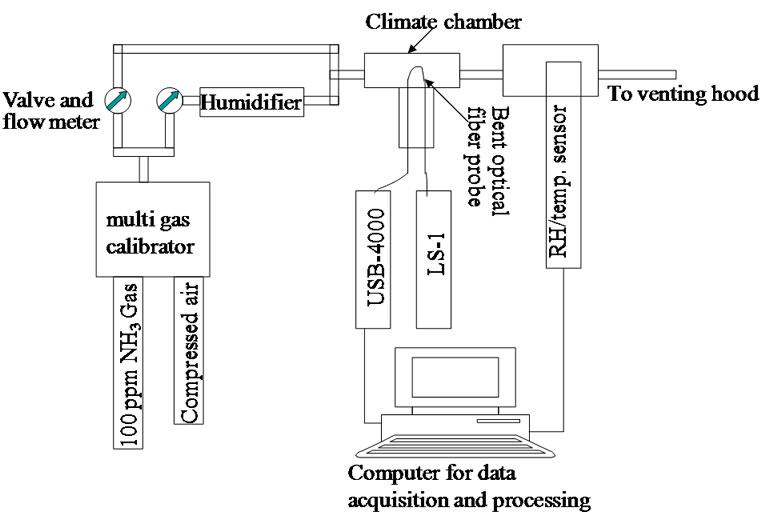
Figure 1. The diagram of laboratory set-up for investigating the response of the bent optical fiber NH3-sensing probe to trace NH3 in air gas samples.
probe’s absorbance signal in this work. An optical fiber compatible light source (LS-1, OceanOptics, Inc) was used to provide light in UV/Vis wavelength region for spectrometric measurement. A multi gas calibrator (Model 146i, Thermo Environmental Instruments Inc., Franklin, MA, USA) was used in diluting the NH3 stock standard gas sample with compressed air to make testing air gas samples.
2.4. Preparing Sensor Probe
A previously reported procedure was followed to prepare bent optical fiber probes. [20,23,24] This process involves bending an optical fiber using a micro flame torch, cleaning the obtained bent optical fiber probe with a K2CrO4/H2SO4 washing solution, and activating bare bent fiber core surface with a 1 M NaOH solution. The activated bent optical fiber probe was then cleaned with DI water before coating polymer and sensing reagent.
An activated and cleaned bent optical fiber probe was first coated with a PMMA membrane by dipping the bare bent part of the probe into the PMMA coating solution, and pulling out slowly. This process repeated three times. The coated probe was dried in air for 10 seconds between the dip-coatings. After letting aging at room temperature in air for at least one hour, the PMMA-coated probe was then coated with CPR using the dip-coating method with the 64 mM CPR as a coating solution. The coated probe is air-dried for one hour before test.
2.5. Laboratory Set-up for Testing the Coated Optical Fiber Probes
In order to test the response of a coated bent optical fiber probe to air samples of different NH3 concentration, the coated bent part of the optical fiber probe was sealed inside plastic climate chamber as shown in Figure 1. The two ends of the bent probe were connected to the optical fiber compatible visible light source (LS-1) and the optical fiber compatible UV/Vis spectrometer (USB-4000) by using SMA connectors, respectively. A testing air gas sample was flowed through the climate chamber, and the optical absorption spectrum of the bent optical fiber probe was recorded using the UV/Vis spectrometer with compressed air as a blank sample. A humidity/temperature sensor (TJ-USB/RH-USB, Omega Engineering, Inc., Stamford, CT, USA), which is sealed inside a tube connected to the exit port of the climate chamber as shown in Figure 1, was used to continuously monitor RH% of the air sample.
3. Result and Discussion
3.1. Spectral Response of CPR to NH3
CPR is a pH indicator. This compound is yellow-colored in a solution having pH < 4.8, and purple-colored when exists in a solution of pH > 6.2. CPR’s peak optical absorption wavelength is 576 nm in a basic solution and 434 nm in an acidic solution. [26] When the dual PMMA/ CPR coated bent optical fiber probe was exposed to air containing 2.0 ppm NH3, an absorption spectrum as showing in Figure 2 was recorded. This absorption spectrum is similar to that of CPR in a basic solution, but peak absorption wavelength is shifted to 595 nm. The peak absorption wavelength in this case is 20 nm redshifted compared with that in a basic solution. It is believed that difference of micro-environment of regent molecules in a solution and a solid phase caused this peak absorption wavelength shift.
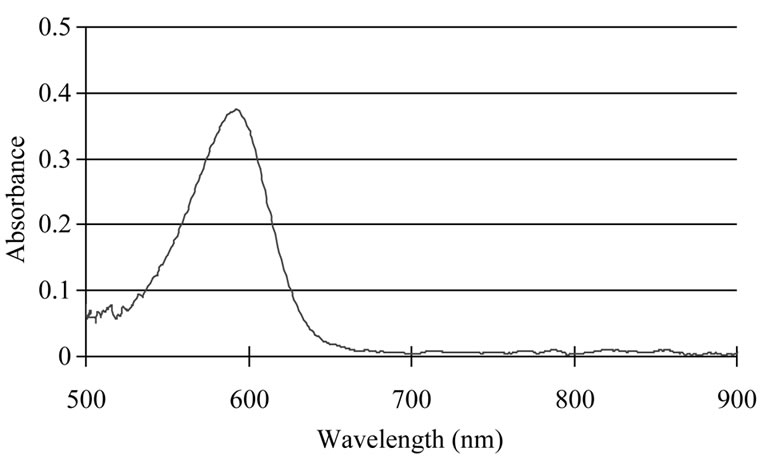
Figure 2. A spectral response of the optical fiber sensor probe exposed to an air sample containing 2.0 ppm NH3. The peak absorption wavelength of the sensing-probe exposed to NH3 is 597 nm, which is around 20 nm red-shifted compared with the absorption spectrum of the same compound (PCR) in a solution with pH > 6.8.
3.2. Method of Fabricating NH3-Sensing Probe
Most reported OFCS for monitoring ammonia have a sensing reagent immobilized inside a polymer, which is coated on the surface of an optical fiber core. [20,23-25, 27,28] The most important advantage of this method for making OFCS is that a sensing reagent is “trapped” inside the pores of a porous polymer or dissolved in a polymer solid phase. This is especially important when such a sensor was developed for detecting a compound in an aqueous solution, because the reagent molecules are prevented from leaking out of the membrane. However, this advantage is not significant when such a sensor was developed for gas sensing. A potential disadvantage of “trapping” the sensing reagent in a polymer in sensor design is the slow response. In this work two methods for preparing NH3-sensing probes were compared. The first method involves dissolving CPR and PMMA together in acetone. The obtained solution was used to coat a bent optical fiber probe. In this case, CPR is trapped inside PMMA. The second method is as that described in Section 2.4, from which a sensing probe having dual PMMA/CPR coatings was made.
Figure 3 shows the time responses of these two sensor probes exposed to air gas samples. The response time, which is defined as the time needed for the sensor to reach 90% of its full scale response, of the sensor probe having CPR immobilized PMMA coating is 64 minutes, while the response time of the sensing probe having dual PMMA/CPR coating is 25 minutes. Obviously, the sensor probe having dual PMMA/CPR coatings has fast response. The sensitivity of these two specific probes for sensing NH3 is also different as demonstrated in Figure
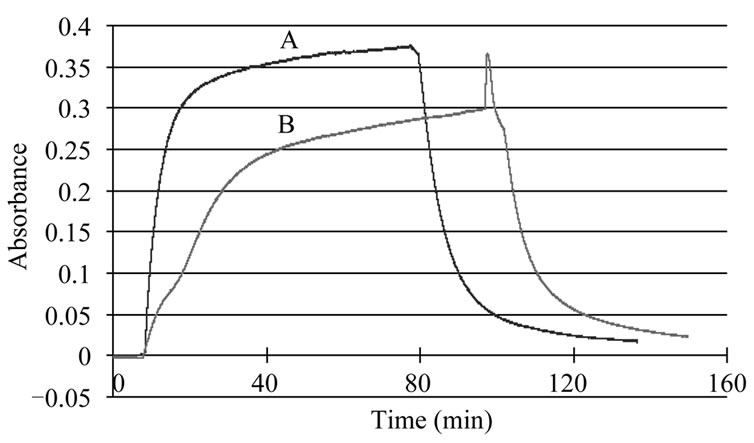
Figure 3. Time response profiles of two optical fiber sensor probes exposed to NH3-containing air gas samples. (A), an optical fiber sensor probe having a dual PCR/PMMA coating exposed to 4.0 ppm NH3-containing air sample; (B), an optical fiber sensor probe having a PCR-immobilized PMMA coating exposed to 25.0 ppm NH3-containing air sample. The absorbance signal spike at 98 minutes was caused by the abrupt change of NH3 concentration when the multi gas calibrator turn off NH3 gas channel.
3. However, many factors affect the sensitivity of such sensors, and it is inappropriate to compare the sensitivity of these two coating methods based on results from these experiments.
The function of the PMMA coating on the surface of silica optical fiber core is for preventing the formation of liquid water membrane on surface of optical fiber sensing probe when the probe was used for monitoring gas samples of high moisture level. The surface of a silica optical fiber core is covered with hydroxide groups, which is highly hydrophilic with strong tendency of absorbing water vapor from surrounding gas. A liquid water membrane will form on such a fiber surface if a bare silica fiber core was exposed to a gas sample of high moisture level. PCR is a water-soluble reagent and can dissolve into the water membrane formed on a fiber core surface. A PCR coating of a different morphology can form when liquid water membrane vaporized after exposing the probe to a dry gas sample. This can change the sensitivity of the sensing probe. PMMA is a hydrophobic polymer. A PMMA coating on the surface of silica optical fiber core converts fiber core surface to be hydrophobic and avoid the formation of liquid water membrane on the surface. The sensitivity stability of the dual PMMA/CPR coating based sensor probe was investigated. The sensor probe was alternatively exposed to an air sample containing 0.40 ppmv NH3 with air humidity RH% = 50% and a blank air sample of high humidity (RH = 80%). The test result showing in Figure 4 indicates that the absorbance change of the sensing probe (after subtracting the baseline shift) after exposed to high
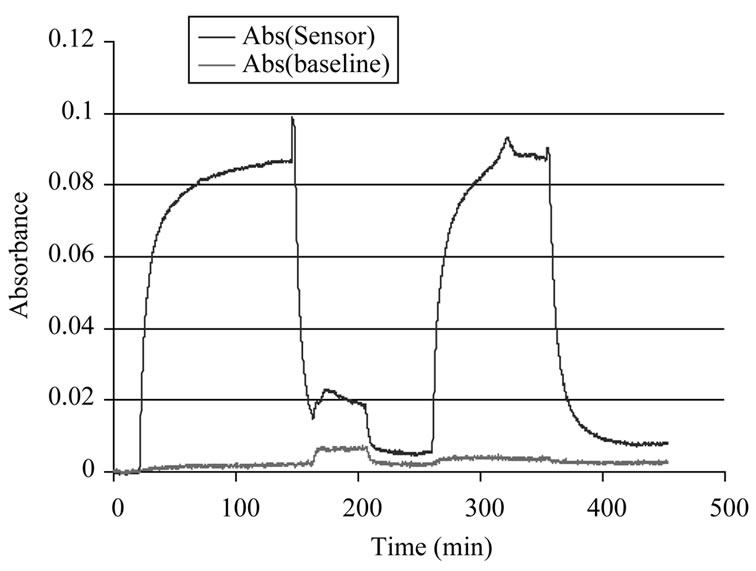
Figure 4. Time response of an optical fiber sensor probe having a dual PCR/PMMA coating exposed alternatively to air samples of low humidity and high humidity. This test result indicates the stability of PCR coating on the surface of PMMA membrane because PMMA is a hydrophobic polymer. The absorbance signal spike at 147 minutes was caused by the abrupt change of NH3 concentration when the multi gas calibrator turn off NH3 gas channel.
humidity air sample is 1.5%. It can be concluded from this result that the CPR coating on the surface of PMMA is stable even exposed to air samples of high humidity.
3.3. Sensitivity, Detection Limit and Reversibility
Figure 5 shows the time response of the sensor exposed to air gas samples (RH% = 47%) of different NH3 concentration. The response (Abs.) of the sensor to ammonia concentration in air is listed in Table 1" target="_self"> Table 1. A calibration curve describing the relationship of sensor’s absorbance signal with NH3 concentration in air samples was built with a linear regression method (Least-squares regression method [29]) using data from Testable 1. The equation is:
Abs. = 0.143CNH3 (ppm) + 0.037 (r2 = 0.994)
From the baseline signal in Figure 5, the standard deviation of blank air sample’s sensing signal is calculated to be 0.00013. The detection limit of this sensor, which is defined as the concentration of NH3 in air sample giving a sensing signal equals three times that of the
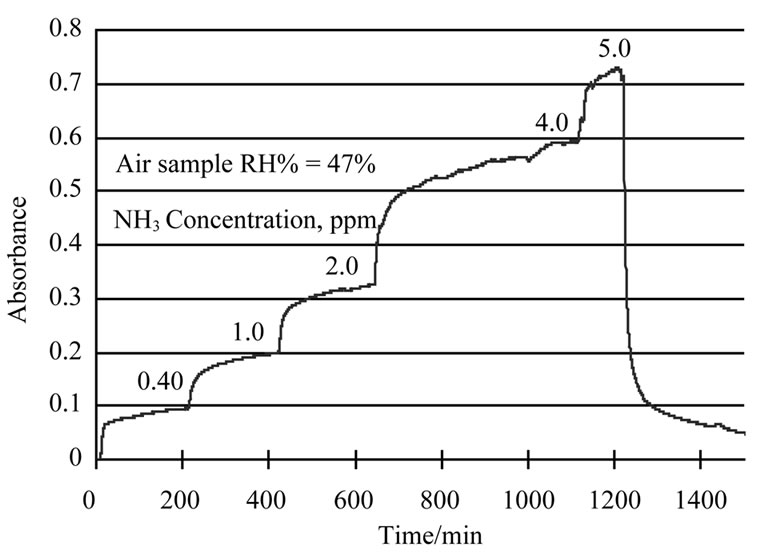
Figure 5. Time response of the optical fiber sensor probe of this work exposed to air samples of different NH3 concentration.
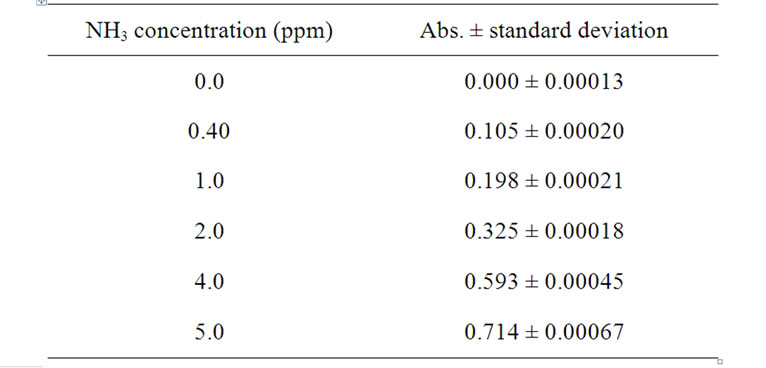
Table 1. Response (Abs.) of the optical fiber ammonia sensor of this work to ammonia in air samples.
standard deviation of blank sample signal, is calculated to be 2.7 ppb.
Figures 4 and 5 clearly demonstrate the reversibility nature of the sensor developed in this work. However, a baseline shift was observed after the sensing probe exposed to high humidity air sample (Figure 4). The mechanism of this baseline shift is not understood at this moment, and will be the topic of further investigations.
4. Conclusions
An optical fiber NH3-sensing probe has been developed for monitoring trace NH3 in gas samples by using a dual-layer PMMA/CPR coated bent optical fiber as a transducer. The dual PMMA/CPR coating probe has faster response compared to the sensing probe having a CPR-immobilized PMMA coating. This sensor is reversible, has a reasonable response time. The sensor is sensitive, has a detection limit of 2.7 ppb, which is the most sensitive optical fiber NH3 sensor to the best knowledge of the authors. The high sensitivity nature makes it very attractive in air quality monitoring because NH3 concentration in ambient air is in tens-ppb range. Further work will be focused on testing the probe for monitoring trace NH3 in ambient air.
5. Acknowledgements
This work was supported by USDA through award number: 2010-65112-20521.
6. References
[1] J. O. Bash, J. T. Walker, G. G. Katul, M. R. Jones, E. Nemitz and W. P. Robarge, “Estimation of in-Canopy Ammonia Sources and Sinks in a Fertilized Zea mays Field,” Environmental Science and Technology, Vol. 44, No. 5, 2010, pp. 1683-1689. doi:10.1021/es9037269
[2] T. Nyord, K. M. Schelde, H. T. Sogaard, L. S. Jensen and S. G. Sommer, “A Simple Model for Assessing Ammonia Emission from Ammoniacal Fertilizers as Affected by pH and Injection into Soil,” Atmospheric Environment, Vol. 42, No. 19, 2008, pp. 4656-4664. doi:10.1016/j.atmosenv.2008.01.051
[3] S. M. McGinn, T. K. Flesch, B. P. Crenna, K. A. Beauchemin and T. Coates, “Quantifying Ammonia Emissions from a Cattle Feedlot Using a Dispersion Model,” Journal of Environmental Quality, Vol. 36, No. 6, 2007, pp. 1585-1590. doi:10.2134/jeq2007.0167
[4] R. W. Todd, N. A. Cole, L. A. Harper, T. K. Flesch and B. H. Baek, “Ammonia and Gaseous Nitrogen Emissions from a Commercial Beef Cattle Feedyard Estimated Using The Flux-Gradient Method and N:P Ratio Analysis,” Proceedings of State of the Science: Animal Manure and Waste Management, San Antonio, 4-7 January 2005, pp. 1-8.
[5] M. B. Rhoades, B. W. Auvermann, N. A. Cole, R. W. Todd, D. B. Parker, E. A. Caraway, G. Schuster and J. Spears, “Ammonia Concentration and Modeled Emission Rates from a Beef Cattle Feedyard,” Proceedings of 2008 ASABE Annual International Meeting, Providence, 29 June-2 July 2008.
[6] C. M. Wathes, M. R. Holden, R. W. Sneath, R. P. White and V. R. Phillips, “Concentrations and Emission Rates of Aerial Ammonia, Nitrous Oxide, Methane, Carbon Dioxide, Dust and Endotoxin in UK Broiler and Layer Houses,” British poultry science, Vol. 38, No. 1, 1997, pp. 14-28. doi:10.1080/00071669708417936
[7] E. F. Wheeler, K. D. Casey, J. S. Zajaczkowski, P. A. Topper, R. S. Gates, H. Xin, Y. Liang and A. Tanaka, “Ammonia Emission from U.S. Poultry Houses: Part III-Broiler Houses,” Proceedings of the 3rd International Conference on Air Pollution from Agricultural Operations, Research Triangle Park, 12-15 October 2003, pp. 159-166.
[8] V. V. Malyshev and A. V. Pislyakov, “Dynamic Properties and Sensitivity of Semiconductor Metal-Oxide Thick-Film Sensors to Various Gases in Air Gaseous Medium,” Sensors and Actuators B: Chemical, Vol. 96, No. 1-2, 2003, pp. 413-434. doi:10.1016/S0925-4005(03)00579-3
[9] B. T. Marquis and J. F. Vetelino, “A Semiconducting Metal Oxide Sensor Array for the Detection of NOx and NH3,” Sensors and Actuators B: Chemical, Vol. 77, No. 1-2, 2001, pp. 100-110. doi:10.1016/S0925-4005(01)00680-3
[10] V. Romanovskaya, M. Ivanovskaya and P. Bogdanov, “A Study of Sensing Properties of Ptand Au-Loaded In2O3 Ceramics,” Sensors and Actuators B: Chemical, Vol. 56, No. 1-2, 1999, pp. 31-36. doi:10.1016/S0925-4005(99)00018-0
[11] K. Chen, Y, Xu, H. Zhang, L. Nie and S. Yao, “Novel Surface Acoustic Wave-Interdigitated Array Electrode Gas Sensor for Dissolved Ammonia,” Fresenius’ Journal of Analytical Chemistry, Vol. 357, No. 4, 1997, pp. 379- 383.
[12] O. K. Varghese, D. Gong, W. R. Dreschel, K. G. Ong, G. Keat and C. A. Grimes, “Ammonia Detection Using Nanoporous Alumina Resistive and Surface Acoustic Wave Sensors,” Sensors and Actuators B: Chemical, Vol. 94, No. 1, 2003, pp. 27-35. doi:10.1016/S0925-4005(03)00252-1
[13] C. Shen, C. Huang and H. Chuo, “The Improved Ammonia Gas Sensors Constructed by L-Glutamic Acid Hydrochloride on Surface Acoustic Wave Devices,” Sensors and Actuators B: Chemical, Vol. 84, No. 2-3, 2002, pp. 231-236. doi:10.1016/S0925-4005(02)00030-8
[14] C. Shen, C. Hsu, R. Hwang and J. Jeng, “The Interference of Humidity on a Shear Horizontal Surface Acoustic Wave Ammonia Sensor,” Sensors and Actuators B: Chemical, Vol. 122, No. 2, 2007, pp. 457-460. doi:10.1016/j.snb.2006.06.017
[15] C. Shen, R. Chen, Y. Shen, L. Wu, C. Huang and J. Jeng, “An Improved System Based on Surface Acoustic Wave Sensors for Reliable Measurement,” Chemical Sensors, Vol. 20, Supplement B, 2004, pp. 266-267.
[16] NIOSH “Organic and Inorganic Gases by Extractive FTIR Spectrometry,” 4th Edition, NIOSH Manual of Analytical Methods, 2000.
[17] Z. Loh, D. Chen, M. Bai, T. Naylor, D. Griffith, J. Hill, T. Denmead, S. McGinn and R. Edis, “Measurement of Greenhouse Gas Emissions From Australian Feedlot Beef Production Using Open-Path Spectroscopy and Atmospheric Dispersion Modeling,” Australian Journal of Experimental Agriculture, Vol. 48, No. 2, 2008, pp. 244-247. doi:10.1071/EA07244
[18] E. D. Thoma, R. C. Shores, E. L. Thompson, D. B. Harris, S. A. Thorneloe, R. M. Varma, R. A. Hashmonay, M. T. Modrak, D. F. Natschke and H. A .Gamble, “Open-Path Tunable Diode Laser Absorption Spectroscopy for Acquisition of Fugitive Emission Flux Data,” Journal of the Air & Waste Management Association, Vol. 55, No. 5, 2005, pp. 658-668.
[19] J. Wang, P. Xie, A. Li, F. Si, K. Dou, W. Fang, F. Wu, Y. Jiang and M. Qin, “Advanced Sensor Systems and Applications IV,” Proceedings of SPIE-The International Society for Optical Engineering, Beijing, 18-20 October 2010, pp. 1-11.
[20] S. Tao, “Optical Fiber Ammonia Sensing Probes Using Reagent Immobilized Porous Silica Coating as Transducers,” Sensors and Actuators B: Chemical, Vol. 115, No. 1, 2006, pp. 158-163.
[21] S. Tao, “Fiber Optic Chemical Sensors for Environmental Monitoring,” In: C. A. Grimes, E. C. Dickey and M. V. Pishko, Eds., Encyclopedia of Sensors, Vol. 3, American Scientific Publishers, Stevenson Ranch, 2006, pp. 449- 473.
[22] M. El-Sherif, “Fiber-Optic Chemical and Biosensors,” Springer Series on Chemical Sensors and Biosensors, Springer, New York, 2010, pp. 109-149.
[23] H. Guo and S. Tao, “Silver Nanoparticles Doped Silicate Nanocomposites Coated on an Optical Fiber for Ammonia sensing,” Sensors and Actuators B: Chemical, Vol. 123, No. 1, 2007, pp. 578-582. doi:10.1016/j.snb.2006.09.055
[24] S. Tao, S. Gong, J. C. Fanguy and X. Hu, “The Application of a Light Guiding Flexible Tubular Waveguide in Evanescent Wave Absorption Optical Sensing,” Sensors and Actuators B: Chemical, Vol. 120, No. 2, 2007, pp. 724-731. doi:10.1016/j.snb.2006.03.039
[25] E. Scorsone, S. Christie, K. C. Persaud, P. Simon and F. Kvasnik, “Fiber-Optic Evanescent Sensing of Gaseous Ammonia with Two Forms of a New Near-Infrared Dye in Comparison to Phenol Red,” Sensors and Actuators B: Chemical, Vol. 90, No. 1-3, 2003, pp. 37-45. doi:10.1016/S0925-4005(03)00019-4
[26] R. W. Sabnis, “Handbook of Acid-Base Indicators,” CRC Press, Boca Raton, 2008.
[27] M. J. Aernecke and D. R. Walt, “Optical-Fiber Arrays for Vapor Sensing,” Sensors and Actuators B: Chemical, Vol. 142, No. 2, 2009, pp. 464-469. doi:10.1016/j.snb.2009.06.054
[28] S. Tao and H. Guo, “Optical Fiber Chemical Sensors for Gas Detection” In: R. V. Harrison, Ed., Chemical Sensors: Properties, Performance and Applications, Nova Science Publishers, Inc., Hauppauge, 2010, pp. 69-92.
[29] D. A. Skoog, D. M. West, F. J. Holler and S. R. Crouch, “Fundamentals of Analytical Chemistry,” 8th Edition, Thomson Learning Inc., Glendale, 2004, pp. 194-206.

